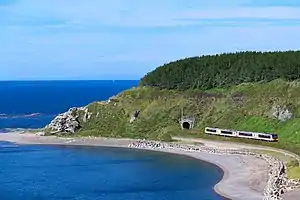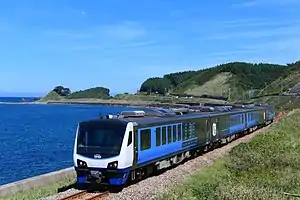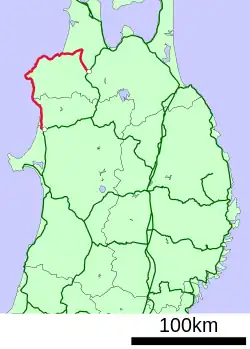| Gonō Line | |||
|---|---|---|---|
 Gono Line | |||
| Overview | |||
| Native name | 五能線 | ||
| Status | In operation | ||
| Owner | JR East | ||
| Locale | Aomori, Akita prefectures | ||
| Termini | |||
| Stations | 43 | ||
| Service | |||
| Type | Heavy rail | ||
| Operator(s) | JR East | ||
| Rolling stock | GV-E400 series DMU, HB-E300 series DMU | ||
| History | |||
| Opened | 1908 | ||
| Technical | |||
| Line length | 147.2 km (91.5 mi) | ||
| Number of tracks | Single track | ||
| Character | Rural and scenic | ||
| Track gauge | 1,067 mm (3 ft 6 in) | ||
| Electrification | None | ||
| Operating speed | 85 km/h (53 mph) | ||
| |||
The Gonō Line (五能線, Gonō-sen) is a railway line in Japan linking Higashi-Noshiro Station in Akita Prefecture with Kawabe Station in Aomori Prefecture, in the northern Tōhoku region of Honshu. The line stretches 147.2 km (91.5 mi) along the Sea of Japan coast with a total of 43 stations. The Gonō Line is operated by East Japan Railway Company (JR East).

Station list
- For the Resort Shirakami rapid service, please see its article.
- Trains may pass at stations marked "◇", "v", or "^".
| Station | Japanese | Distance (km) | Transfers | Location | ||||
|---|---|---|---|---|---|---|---|---|
| Between stations |
Total | Rapid | ||||||
| Higashi-Noshiro | 東能代 | - | 0.0 | ● | Ōu Main Line | v | Noshiro | Akita |
| Noshiro | 能代 | 3.9 | 3.9 | ● | ◇ | |||
| Mukai-Noshiro | 向能代 | 2.2 | 6.1 | ↑ | | | |||
| Kita-Noshiro | 北能代 | 3.2 | 9.3 | ↑ | | | |||
| Torigata | 鳥形 | 1.9 | 11.2 | ↑ | | | |||
| Sawame | 沢目 | 2.9 | 14.1 | ↑ | | | Happō, Yamamoto District | ||
| Higashi-Hachimori | 東八森 | 3.9 | 18.0 | ↑ | | | |||
| Hachimori | 八森 | 4.7 | 22.7 | ↑ | | | |||
| Takinoma | 滝ノ間 | 1.8 | 24.5 | ↑ | | | |||
| Akitashirakami | あきた白神 | 1.6 | 26.1 | ● | | | |||
| Iwadate | 岩館 | 3.0 | 29.1 | ● | ◇ | |||
| Ōmagoshi | 大間越 | 10.8 | 39.9 | ↑ | | | Fukaura, Nishitsugaru District | Aomori | |
| Shirakamidaketozanguchi | 白神岳登山口 | 2.4 | 42.3 | ↑ | | | |||
| Matsukami | 松神 | 2.4 | 44.7 | ↑ | | | |||
| Jūniko | 十二湖 | 1.9 | 46.6 | ● | | | |||
| Mutsu-Iwasaki | 陸奥岩崎 | 4.3 | 50.9 | ↑ | | | |||
| Mutsu-Sawabe | 陸奥沢辺 | 2.7 | 53.6 | ↑ | | | |||
| WeSPa-Tsubakiyama | ウェスパ椿山 | 2.4 | 56.0 | ● | | | |||
| Henashi | 艫作 | 1.9 | 57.9 | ↑ | | | |||
| Yokoiso | 横磯 | 3.5 | 61.4 | ↑ | | | |||
| Fukaura | 深浦 | 5.5 | 66.9 | ● | ◇ | |||
| Hiroto | 広戸 | 3.9 | 70.8 | ↑ | | | |||
| Oirase | 追良瀬 | 2.1 | 72.9 | ↑ | | | |||
| Todoroki | 驫木 | 3.1 | 76.0 | ↑ | | | |||
| Kasose | 風合瀬 | 3.0 | 79.0 | ↑ | | | |||
| Ōdose | 大戸瀬 | 4.9 | 83.9 | ↑ | | | |||
| Senjōjiki | 千畳敷 | 2.1 | 86.0 | ● | | | |||
| Kita-Kanegasawa | 北金ヶ沢 | 4.6 | 90.6 | ● | ◇ | |||
| Mutsu-Yanagita | 陸奥柳田 | 2.7 | 93.3 | ↑ | | | |||
| Mutsu-Akaishi | 陸奥赤石 | 4.1 | 97.4 | ↑ | | | Ajigasawa, Nishitsugaru District | ||
| Ajigasawa | 鰺ヶ沢 | 6.4 | 103.8 | ● | ◇ | |||
| Narusawa | 鳴沢 | 4.5 | 108.3 | ● | | | |||
| Koshimizu | 越水 | 2.7 | 111.0 | ● | | | Tsugaru | ||
| Mutsu-Morita | 陸奥森田 | 3.4 | 114.5 | ● | | | |||
| Nakata | 中田 | 2.4 | 116.9 | ● | | | |||
| Kizukuri | 木造 | 2.6 | 119.5 | ● | | | |||
| Goshogawara | 五所川原 | 5.2 | 125.7 | ● | Tsugaru Railway Line (Tsugara-Goshogawara) | ◇ | Goshogawara | |
| Mutsu-Tsuruda | 陸奥鶴田 | 6.0 | 131.7 | ● | | | Tsuruta, Kitatsugaru District | ||
| Tsurudomari | 鶴泊 | 2.4 | 134.1 | ● | | | |||
| Itayanagi | 板柳 | 4.8 | 138.9 | ● | ◇ | Itayanagi, Kitatsugaru District | ||
| Hayashizaki | 林崎 | 3.0 | 141.9 | ● | | | Fujisaki, Minamitsugaru District | ||
| Fujisaki | 藤崎 | 2.8 | 144.7 | ● | | | |||
| Kawabe | 川部 | 2.5 | 147.2 | ● | Ōu Main Line | ^ | Inakadate, Minamitsugaru District | |
| Most trains have through service to Hirosaki station on the Ōu Main Line | ||||||||
Rolling stock
 Kiha 40 series
Kiha 40 series HB-E300 series "Resort Shirakami"
HB-E300 series "Resort Shirakami" GV-E400 series
GV-E400 series
- KiHa 40 series DMU
- HB-E300 series DMU
- GV-E400 series DMU
History
The first section of the Gonō Line was opened by the Japanese Government Railways (JGR) from Higashi-Noshiro to Noshiro in 1908. When every JGR railway line was assigned a line name on October 12, 1909, this short railway was named the Noshiro Line (能代線, Noshiro-sen). In 1926 it was extended to Iwadate and in 1932 extended to Mutsu-Iwasaki.
The private Mutsu Railway (陸奥鉄道, Mutsu-tetsudō) began operations on September 25, 1918 linking Kawabe with Goshogawara. The line was extended to Mutsu-Morita on October 21, 1924 with the extension called the Goshogawara Line (五所川原線, Goshogawara-sen). The line was extended to Ajigasawa on May 15, 1925. The company was nationalized in 1927, with the Goshogawara Line being absorbed into the Mutsu Railway. The line was extended to Mutsu-Akaishi on November 26, 1929 and connected to the Gonō Line on July 30, 1936, at which time the entire line adopted its current name.
A CTC system was installed in 1986. With the privatization of the Japanese National Railways (successor of JGR) on April 1, 1987, the Gonō Line came under the control of the East Japan Railway Company (JR East).
See also
References
- Harris, Ken; Clarke, Jackie (2008). Jane's World Railways 2008-2009. Jane's Information Group. ISBN 978-0-7106-2861-9.
Further reading
External links
- JR East website (in Japanese)
